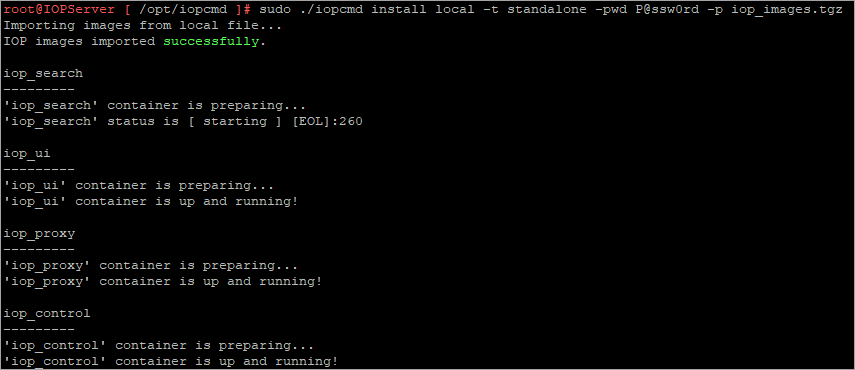The following article walks you through the installation of the Linux-based deployment of Insights On-Premises (IOP). This installation type provides an alternative to the OVA-based deployment, for which you require a dedicated vCenter machine. The advantages of the Linux-based deployment is that you can choose any supported Linux distribution and run the installation from the CLI.
Installation Files
Contact our support team at support@controlup.com to receive the latest on-premises installation files and guidance through the installation.
Prerequisites
Verify that your Linux machine meets the general IOP prerequisites.
The Linux /var directory must have at least 25 GB available.
Supported Operating Systems
- Photon OS 5.0
- Ubuntu 22.04.1. Note that this is the final Linux that IOP will deploy.
Installed Software on the Linux machine
- Docker 20.10.14 or later
Installation
Throughout the following section, we walk you through the installation of both standalone and clustered IOP servers. Before you install the IOP server, you must decide which mode to install:
- For small environments with fewer than 5,000 sessions, we recommend a standalone installation.
- For environments with more than 5,000 sessions, you should set up a clustered IOP infrastructure.
Follow the installation instructions according to your preferred deployment mode.
The Linux-based deployment of IOP supports data migration only from IOP version 8.7 to 8.8 MR2. To perform the migration, follow the steps here.
Standalone Machine
- Download the iop_8.x_images_stable.tgz and iopcmd-8.x.[xxx.xx].tgz to your Windows machine.
- Transfer both files to the /opt directory of your Linux machine. In our example, we use WinSCP to transfer both files.
[root@localhost opt]# ll -ltr total 1003584 -rw-r--r--. 1 root root 12245632 Feb 7 05:55 iopcmd-8.x.x.xx.tgz -rw-r--r--. 1 root root 1015420863 Feb 7 06:36 iop_x.x_images_stable.tgz - In the /opt directory, extract the iopcmd-8.x.[xxx.xx].tgz. A new directory iopcmd is created.
sudo tar zxvf iopcmd-8.x.xxx.xx.tgz - Move the iop_8.x_images_stable.tgz file from the /opt directory to the /opt/iopcmd folder.
sudo mv iop_8.x_images_stable.tgz /opt/iopcmd/iop_images.tgz - Run the script to install the standalone server. Use the -t standalone parameter and provide a strong password, for example P@ssw0rd.
The password must be at least 8 alphanumeric characters in length and contain at least one of the following special characters: ~ @ % ^ - _ =
When the script finishs, following output should appear:sudo ./iopcmd install local -t standalone -pwd P@ssw0rd -p iop_images.tgz

IOP Cluster
The following section guides you through the installation of an IOP cluster which consists of one master node and at least two data nodes. Install the master node first, and then each data node sequentially. In our example, the master node has the IP address 10.20.63.14, while the data nodes have 10.20.63.15 and 10.20.63.16.
1. Install the Master Node
To install the master node:
-
Download the iop_8.x_images_stable.tgz and iopcmd-8.x.[xxx.xx].tgz to your Windows machine.
-
Transfer both files to the /opt directory of your master node. In our example, we use WinSCP to transfer both files.
[root@localhost opt]# ll -ltr total 1003584 -rw-r--r--. 1 root root 12245632 Feb 7 05:55 iopcmd-8.x.xxx.xx.tgz -rw-r--r--. 1 root root 1015420863 Feb 7 06:36 iop_8.x_images_stable.tgz -
From the /opt directory, extract the iopcmd-8.x.[xxx.xx].tgz. A new directory iopcmd is created.
sudo tar zxvf iopcmd-8.x.xxx.xx.tgz -
Move the iop_8.x_images_stable.tgz file from the /opt directory to the /opt/iopcmd folder.
sudo mv iop_8.x_images_stable.tgz /opt/iopcmd/iop_images.tgz -
Run the following command to install the master node. In our example, we use the password P@ssw0rd and type master after the -t parameter.
sudo ./iopcmd install local -t master -pwd P@ssw0rd -p iop_images.tgz
Once the script is complete, you see the following success response message:
Importing images from local file...
IOP images imported successfully.
iop_ui
---------
'iop_ui' container is preparing...
'iop_ui' container is up and running!
iop_proxy
---------
'iop_proxy' container is preparing...
'iop_proxy' container is up and running!
iop_control
---------
'iop_control' container is preparing...
'iop_control' container is up and running!
Run the sudo docker ps command to verify that all IOP containers are running:
[root@localhost iopcmd]$ sudo docker ps
CONTAINER ID IMAGE COMMAND CREATED STATUS PORTS NAMES
118a2a25e211 iop_control:local "hypercorn '-w 1' -b…" 8 minutes ago Up 8 minutes (healthy) 0.0.0.0:8777->8777/tcp, :::8777->8777/tcp iop_control
493c305b918a iop_proxy:local "/docker-entrypoint.…" 8 minutes ago Up 8 minutes (healthy) 0.0.0.0:80->80/tcp, :::80->80/tcp, 0.0.0.0:443->443/tcp, :::443->443/tcp iop_proxy
ce81be77e92a iop_ui:local "docker-entrypoint.s…" 8 minutes ago Up 8 minutes 0.0.0.0:3000->3000/tcp, :::3000->3000/tcp iop_ui
73c32dd1e734 iop_base:local "./start.sh start-se…" 10 minutes ago Up 10 minutes (healthy) 8065/tcp, 8088-8089/tcp, 8191/tcp, 9887/tcp, 0.0.0.0:8000->8000/tcp, :::8000->8000/tcp, 9997/tcp iop_search
51f63a7fce70 iop_base:local "./start.sh start-se…" 13 minutes ago Up 13 minutes (healthy) 8000/tcp, 8065/tcp, 0.0.0.0:8080->8080/tcp, :::8080->8080/tcp, 8088/tcp, 8191/tcp, 9887/tcp, 9997/tcp, 0.0.0.0:8089->8089/tcp, :::8089->8089/tcp iop_master
The next step is to install your first data node and connect it to the master node that you just installed.
2. Install the Data Nodes
The installation of data nodes isn't very different from the installation of the master node. The only exception is that you have to provide the hostname or IP address of the master node in the installation script as well as define the type data in the -t parameter.
To install your first data node:
-
Repeat steps 1 through 4 from the master node installation. Make sure to place the files onto your data node.
-
Run the installation script with the -t data switch and provide the IP address of the master node
sudo ./iopcmd install local -t data -m 10.20.63.14 -pwd P@ssw0rd -p iop_images.tgz
The IOP images imported successfully response indicates a successful importation of the images.
[root@localhost iopcmd]$ sudo ./iopcmd install local -t data -m 10.20.63.14 -pwd P@ssw0rd -p iop_images.tgz
Importing images from local file...
IOP images imported successfully.
Use the same installation instructions for the other data nodes.